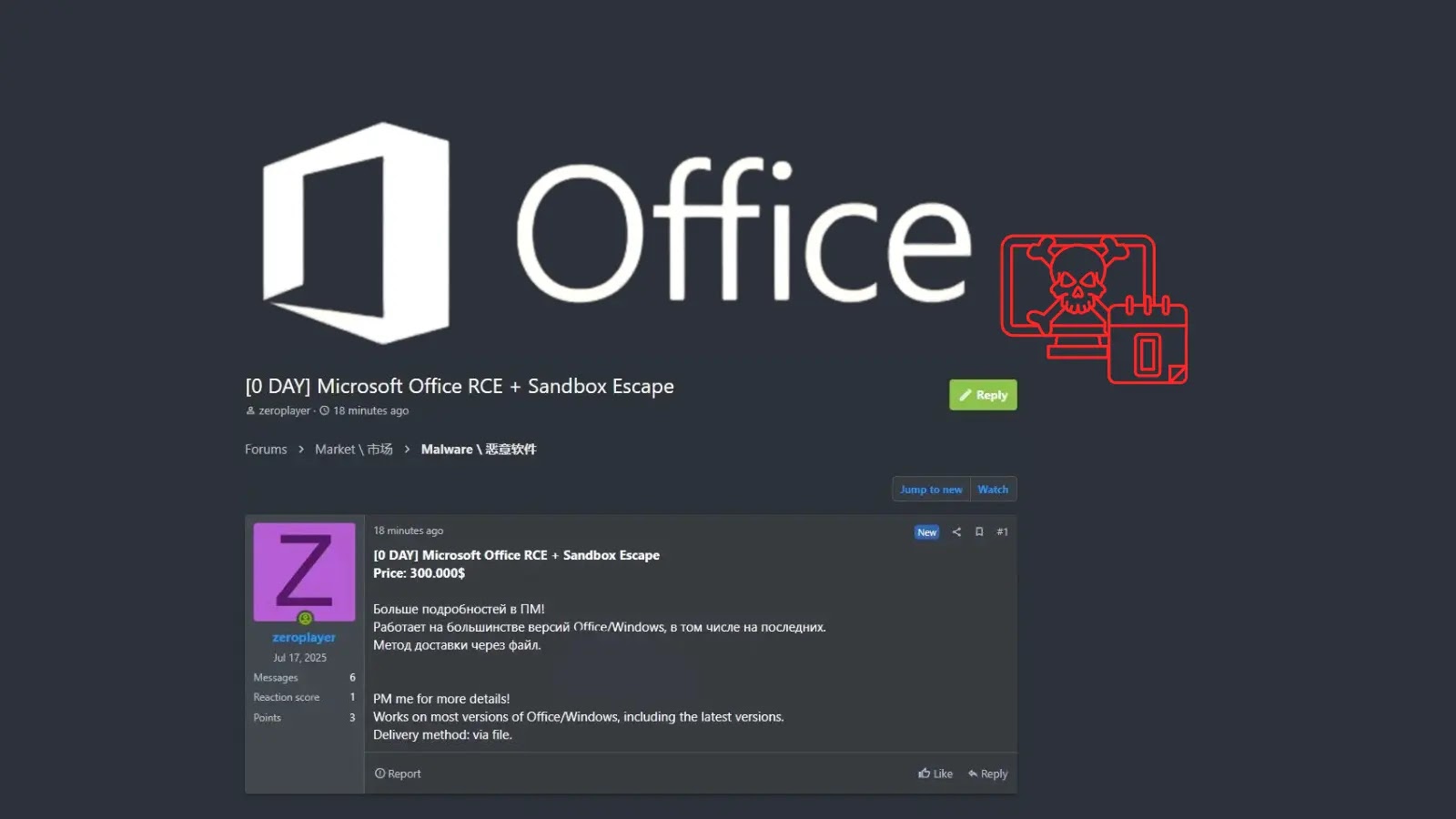
Threat Actors Allegedly Selling Microsoft Office 0-Day RCE Vulnerability on Hacking Forums
The digital threat landscape is in a constant state of flux, and a recent development underscores this reality with alarming clarity. Reports from underground hacking forums indicate that a new, highly potent zero-day vulnerability targeting Microsoft Office and Windows systems is allegedly up for sale. This isn’t just any exploit; it’s a Remote Code Execution (RCE) vulnerability combined with a sandbox escape, a dangerous pairing that could grant attackers significant control over compromised systems. Its purported availability and asking price of $30,000 on the dark web signal a serious escalation for cybersecurity professionals worldwide.
The Alleged Microsoft Office 0-Day RCE Exploit
A threat actor identified as “Zeroplayer” is reportedly advertising a critical zero-day vulnerability. This exploit specifically targets Microsoft Office applications and Windows operating systems. What makes this particular offering so concerning is its nature: a Remote Code Execution (RCE) capability. An RCE vulnerability allows an attacker to execute arbitrary code on a victim’s machine remotely, essentially taking control of the system without direct physical access.
Compounding the danger, the exploit allegedly includes a sandbox escape. Sandboxing is a security mechanism designed to isolate applications, preventing them from accessing critical system resources or data outside their designated environment. A successful sandbox escape means the attacker can bypass these protective layers, potentially gaining wider access and deeper control over the compromised system. The seller claims the exploit works across most Office file formats, including the latest versions, and even affects fully patched Windows installations—a particularly worrying detail, as it suggests traditional patching routines may not fully mitigate the risk yet.
Understanding Zero-Day Vulnerabilities and RCE
A zero-day vulnerability refers to a security flaw that is unknown to the software vendor (in this case, Microsoft) and for which no official patch or fix exists. This makes them exceptionally dangerous because defenders have no immediate way to protect against them. Attackers, once they discover or acquire such an exploit, have a significant advantage as they can leverage it before the vendor can develop and deploy a countermeasure.
Remote Code Execution (RCE) is a severe class of vulnerability that allows an attacker to execute arbitrary code on a target machine from a remote location. This can lead to complete system compromise, data exfiltration, installation of malware, and broader network attacks. When combined with a sandbox escape, an RCE vulnerability offers an attacker an almost unfettered ability to carry out malicious activities on the victim’s system, bypassing foundational security controls.
The Risk to Organizations and Individuals
The alleged sale of this Microsoft Office 0-day RCE on hacking forums poses a substantial risk to both organizations and individual users. A successful attack exploiting such a vulnerability could lead to:
- Data Breaches: Attackers could access and exfiltrate sensitive corporate data, personal information, and intellectual property.
- System Compromise: Complete control over affected systems, allowing for the installation of ransomware, spyware, or other malicious software.
- Lateral Movement: Compromised machines can serve as launching pads for attacks on other systems within a network, leading to widespread infection.
- Disruption of Operations: Malicious actors could disrupt critical business operations, leading to financial losses and reputational damage.
Given the ubiquity of Microsoft Office in corporate and personal environments, the potential impact of such an exploit is immense.
Remediation Actions and Proactive Defense
While an official patch for a zero-day vulnerability is by definition unavailable, organizations and users are not entirely without options. Proactive defense strategies are crucial:
- Enable Macro Security: Configure Microsoft Office to disable macros by default or only allow digitally signed macros from trusted publishers. Many Office-based exploits rely on malicious macros.
- Implement Application Control: Utilize tools that restrict which applications can run on endpoints. This can prevent unauthorized or malicious executables from launching, even if an RCE is achieved.
- Principle of Least Privilege: Ensure users operate with the minimum necessary permissions. This limits the potential damage an attacker can inflict even if a user’s account is compromised.
- Network Segmentation: Isolate critical systems and sensitive data on separate network segments. This can contain the spread of an attack, even if an initial compromise occurs.
- Advanced Endpoint Detection and Response (EDR): Deploy EDR solutions that can detect anomalous behavior, suspicious processes, and potential exploit attempts in real-time.
- Regular Backups: Maintain reliable, off-site backups of all critical data. This is essential for recovery in the event of a successful ransomware or data-wiping attack.
- User Awareness Training: Educate users about the dangers of phishing emails, suspicious attachments, and social engineering tactics often used to deliver exploits.
- Monitor Threat Intelligence: Stay updated on the latest threats and vulnerabilities. As more information emerges about this alleged zero-day, adjust defenses accordingly.
Relevant Tools for Detection and Mitigation
Here are some types of tools that can help in detecting and mitigating threats, especially in the context of advanced vulnerabilities:
| Tool Category | Purpose | Examples / Link |
|---|---|---|
| Endpoint Detection & Response (EDR) | Detects and responds to advanced threats and suspicious activities on endpoints. | Microsoft Defender for Endpoint, CrowdStrike Falcon, SentinelOne |
| Application Whitelisting/Control | Prevents unauthorized applications from executing, enhancing protection against unknown executables. | Windows Defender Application Control (WDAC), AppLocker |
| Vulnerability Management Solutions | Identifies and manages known vulnerabilities across an organization’s assets. While not for 0-days directly, crucial for overall security posture. | Tenable.io, Qualys, Rapid7 InsightVM |
| Email Security Gateways | Filters malicious emails, attachments, and links before they reach user inboxes. | Mimecast, Proofpoint, Cisco Email Security |
Conclusion
The alleged sale of a Microsoft Office 0-day RCE vulnerability with a sandbox escape capability on hacking forums represents a significant threat to digital security. While direct identification and patching of a zero-day are impossible until known to the vendor, a robust, multi-layered security strategy can significantly reduce an organization’s attack surface and improve its resilience. It’s imperative that IT and security teams remain vigilant, apply defense-in-depth principles, and continuously monitor for emerging threats to safeguard their digital assets. Staying informed and proactive is the best defense against such advanced and elusive cyber threats.





